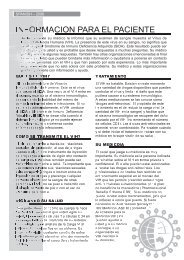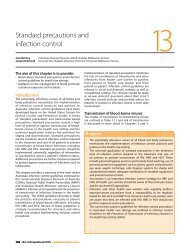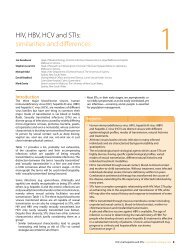B Positive – all you wanted to know about - ASHM
B Positive – all you wanted to know about - ASHM
B Positive – all you wanted to know about - ASHM
Create successful ePaper yourself
Turn your PDF publications into a flip-book with our unique Google optimized e-Paper software.
Introduction<br />
Maintaining the safety of the health care<br />
environment for patients and health<br />
professionals is essential and necessitates the<br />
implementation of infection control guidelines.<br />
the current best practice guidelines for<br />
infection control procedures in australia are<br />
outlined in Infection Control Guidelines for the<br />
Prevention of Transmission of Infectious Diseases<br />
in the Health Care Setting. 1 these guidelines are<br />
based on the model of universal precautions<br />
developed in 1987 by the united states centers<br />
for disease control and Prevention (cdc).<br />
state and terri<strong>to</strong>ry Health departments in<br />
australia have adopted a broader definition<br />
of universal precautions and have introduced<br />
the principle of standard precautions. standard<br />
precautions ensure a high level of protection<br />
against transmission of infection in the health<br />
care setting and represent the level of infection<br />
control required in the treatment and care of <strong>all</strong><br />
patients <strong>to</strong> prevent the transmission of bloodborne<br />
infections.<br />
the implementation of standard precautions<br />
minimises the risk of transmission of the<br />
infection from patient-<strong>to</strong>-clinician, clinician-<strong>to</strong>patient<br />
and patient-<strong>to</strong>-patient, even in high-risk<br />
situations. the use of additional precautions<br />
is only recommended during the care of<br />
patients <strong>know</strong>n or suspected <strong>to</strong> be infected or<br />
colonised with disease agents that may not be<br />
contained by standard precautions alone, such<br />
as tuberculosis.<br />
clinicians and other health care workers<br />
need <strong>to</strong> be aware that infection control<br />
guidelines are relevant in social and domestic<br />
contexts, as well as in occupational settings.<br />
the implementation of infection control<br />
guidelines in social and domestic settings can<br />
assist patients with hepatitis b virus (HbV) <strong>to</strong><br />
reduce the risk of transmission <strong>to</strong> family and<br />
household contacts. clinicians should be able<br />
<strong>to</strong> answer patients’ questions <strong>about</strong> a clinic’s<br />
infection control policies and provide advice<br />
for patients in relation <strong>to</strong> infection control in<br />
their daily environment. this chapter provides<br />
an overview of the current australian infection<br />
control guidelines and their relevance in<br />
treating patients with HbV.<br />
Transmission<br />
chapter 4: natural his<strong>to</strong>ry of chronic hepatitis b<br />
virus infection, outlines the modes and risks of<br />
HbV transmission. the transmission of HbV is<br />
approximately 100 times more efficient than<br />
the transmission of HiV and approximately 10<br />
times more efficient than HcV. 2<br />
the risk of blood-borne virus transmission is<br />
dependent on a number of fac<strong>to</strong>rs. incidents<br />
involving blood-<strong>to</strong>-blood contact with<br />
infectious blood are associated with a high risk<br />
of infection when:<br />
� there is a large quantity of blood, indicated<br />
by visible contamination<br />
� a needle is inserted directly in<strong>to</strong> a vein or<br />
artery or body cavity<br />
� the patient has high levels of HbV dna and<br />
detectable Hbeag; HcV ribonucleic acid<br />
(rna) detected by polymerase chain reaction<br />
(Pcr); the patient suffers from advanced HiV<br />
disease and has a high HiV viral load.<br />
Patient-<strong>to</strong>-patient transmission of HbV,<br />
although rare, has been associated with oral<br />
surgery, and inadequate use or disinfection of<br />
medical devices, such as blood glucose finger<br />
stick devices and acupuncture needles. 2-4<br />
Worldwide, published incident reports indicate<br />
that a <strong>to</strong>tal of 12 health care workers with<br />
HbV infection have transmitted the virus <strong>to</strong><br />
approximately 91 patients. 5 the transmission of<br />
HbV in the health care setting can be prevented<br />
through health care worker, patient and<br />
community hepatitis b vaccination programs<br />
and strict adherence <strong>to</strong> standard precautions.<br />
Standard precautions<br />
standard precautions ensure a high level<br />
of protection against the transmission of<br />
infections, including blood-borne viruses in the<br />
health care setting, and are recommended for<br />
the care and treatment of <strong>all</strong> patients and in the<br />
handling of:<br />
� blood, including dried blood<br />
� <strong>all</strong> other body substances, secretions and<br />
excretions (excluding sweat), regardless of<br />
whether they contain visible blood<br />
� non-intact skin<br />
� Mucous membranes.<br />
b <strong>Positive</strong> <strong>–</strong> <strong>all</strong> <strong>you</strong> <strong>wanted</strong> <strong>to</strong> <strong>know</strong> <strong>about</strong> hepatitis b: a guide for primary care providers 83






